THE TEMPTATIONS
*****
Released August 30, “I Can’t Get Next To You” peaked at #1 (5 weeks) on the Billboard R&B chart in 1969. B-side: “Running Away (Ain’t Gonna Help You)”
GORDY 7093 (Source: Billboard Top R&B Singles)
![]()

ECHOES OF TIGER STADIUM * Joe Falls * 1999

ABOUT THIS RECORDING
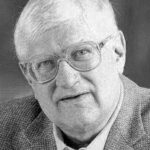 In 1999, Joe Falls commiserated the closing of Tiger Stadium by recording and interviewing many of those who played and called “Tiger Stadium their home.” At the time these interviews were conducted, Joe Falls had been a Detroit Sports writer for 53 years, while having covered the Detroit Tigers for 47 years, In the 1960s, Falls was the sports editor at the Detroit Free Press.
In 1999, Joe Falls commiserated the closing of Tiger Stadium by recording and interviewing many of those who played and called “Tiger Stadium their home.” At the time these interviews were conducted, Joe Falls had been a Detroit Sports writer for 53 years, while having covered the Detroit Tigers for 47 years, In the 1960s, Falls was the sports editor at the Detroit Free Press.
The legendary sports reporter also was a member of the Baseball Hall of Fame. Falls’ interviews were highlighted on WJR 760 throughout the Detroit Tigers’ baseball season, 1999, the final year of Tiger Stadium’s history.
George Cantor, the famed lead reporter covering the Detroit Tigers for the Detroit Free Press in the 1960s, relates of his own personal memories of Tiger Stadium as a child growing up in the Motor City, and covering the team as a newspaper reporter. His recollections opens the introduction to this Joe Falls collection of recordings and interviews from 20 years ago.
Cantor is the author of ‘The Tigers of ’68: Baseball’s Last Real Champions‘, published in 1997.
— DARNELL BROOKES COLLECTION —
NEW! A special THANK YOU to Darnell Brookes of Midland, Michigan, for recently sharing (September 2019) this Detroit sports audio memory (and information of this recording he provided as well) with Motor City Radio Flashbacks, as featured today.

IN THIS RECORDING YOU WILL HEAR THE VOICES OF:
Joe Falls; George Cantor; Kirk Gibson; Fr. Vincent Horken; Willie Horton; Jim Schmakel; Jim Price; Ted Williams; Paul Carey; Virgil Trucks;Jack Morris; Frank Fenick; Frank Beckmann; Mayor Dennis Archer; Tom Gage; Tony Clark; John McHale, Jr.; Gates Brown; Larry Parrish; Mark Fidrych; Dave Bergman; Max Lipes; Sonny Eliot; George Kell; John Hiller; Mickey Stanley; Bob Talbert; Earl Wilson; Denny McLain; Harmon Killebrew; Ernie Harwell; Charlie Maxwell; Ralph Snyder; Al Kaline; Steve Boros; Fred Smith; Billy Rogell; Alan Trammell; Bill Freehan; Mike Illitch; Mickey Lolich; Sparky Anderson; Jim Northrup; Irwin Cohen; Dan Petry; Dan Ewald; Jim Hendricks; Lance Parrish; Frank Tanana; Jim Bunning; Paul W. Smith; Conclusion
Joe Falls passed away on August 11, 2004. He was 76. George Cantor passed away on August 13, 2010, he was 69.
(Created by Joe Falls. Produced by Irwin Cohen, Primeau Productions; 1999)
— PHOTO CREDIT —
— Tiger Stadium photo (above): Bill Edwards; July 2008 —
— THE FINAL GAME at TIGER STADIUM —
In commemoration of the anniversary since Tiger Stadium formally closed twenty years ago, Motor City Radio Flashbacks last month featured the entire “last game” played at the Corner on September 27, 1999.
If you missed our special (September 27, 2019) feature, you can find it now archived on this site, HERE.

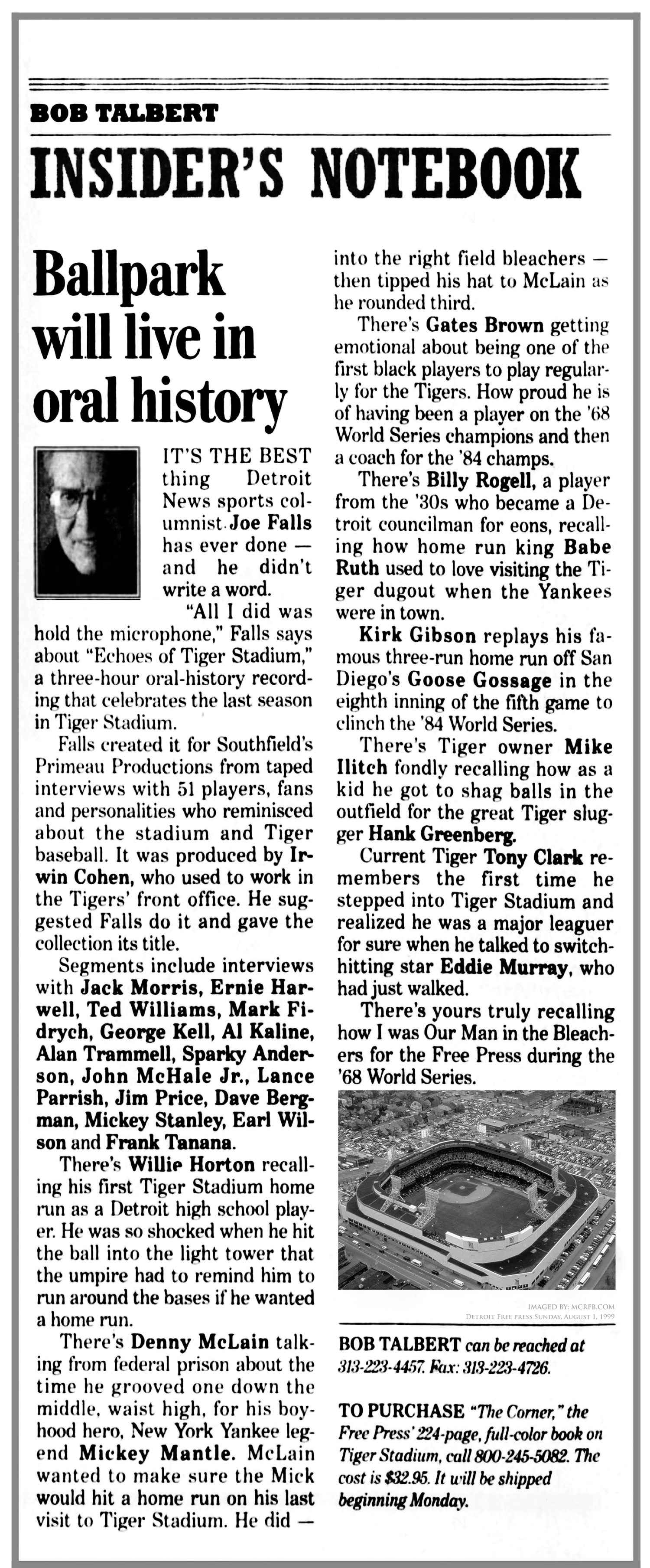

![]()

BRAND NEW! 4 YEARS IN THE MAKING . . . .
AVAILABLE NOW IN DIGITAL AND BOOK FORM!
Hey, we have great news shared from our friend, Scott Westerman, over at Keener13.com —
At long last, the Keener legend is in print. It’s a tale 56 years in the making and 4 years in production, with biographical sketches of many of the original WKNR personalities, popular culture highlights from each year of the Keener era and scans of 9 years of WKNR Music Guides.
Motor City Music – Keener13 and the Soundtrack of Detroit tells the story of Keener’s birth and how Bob Green, Dick Purtan, Jerry Goodwin, Robin Seymour and others found their way to the Detroit airwaves. There are classic tales of Keener and the Beatles, a contest that almost landed WKNR in court and the station’s power to raise a half million dollars for charity during a newspaper strike.
 We meet two of the men behind the scenes, program director, Frank Maruca and chief engineer Jerry Martin, a duo who help craft both the sound and the vibe that made WKNR jump out of your radio and into your heart.
We meet two of the men behind the scenes, program director, Frank Maruca and chief engineer Jerry Martin, a duo who help craft both the sound and the vibe that made WKNR jump out of your radio and into your heart.
Music guide buffs will love watching their favorite hits ride up and down the charts, watching how the promotional pictures of the announcers morphed over the years and remembering some of the products that Keener helped sell to thousands of fans across the Motor City.
Motor City Music is a true trip down memory lane, a required reference for those of us who followed the music and a loving tribute to the talent that transformed a 5,000 watt AM station that barely covered the market into a powerhouse that became the soundtrack of our lives.
Grab your copy of Motor City Music – Keener13 and the Soundtrack of Detroit in either print or digital form at Amazon.com.
Scott Westerman
October 1, 2019

![]()

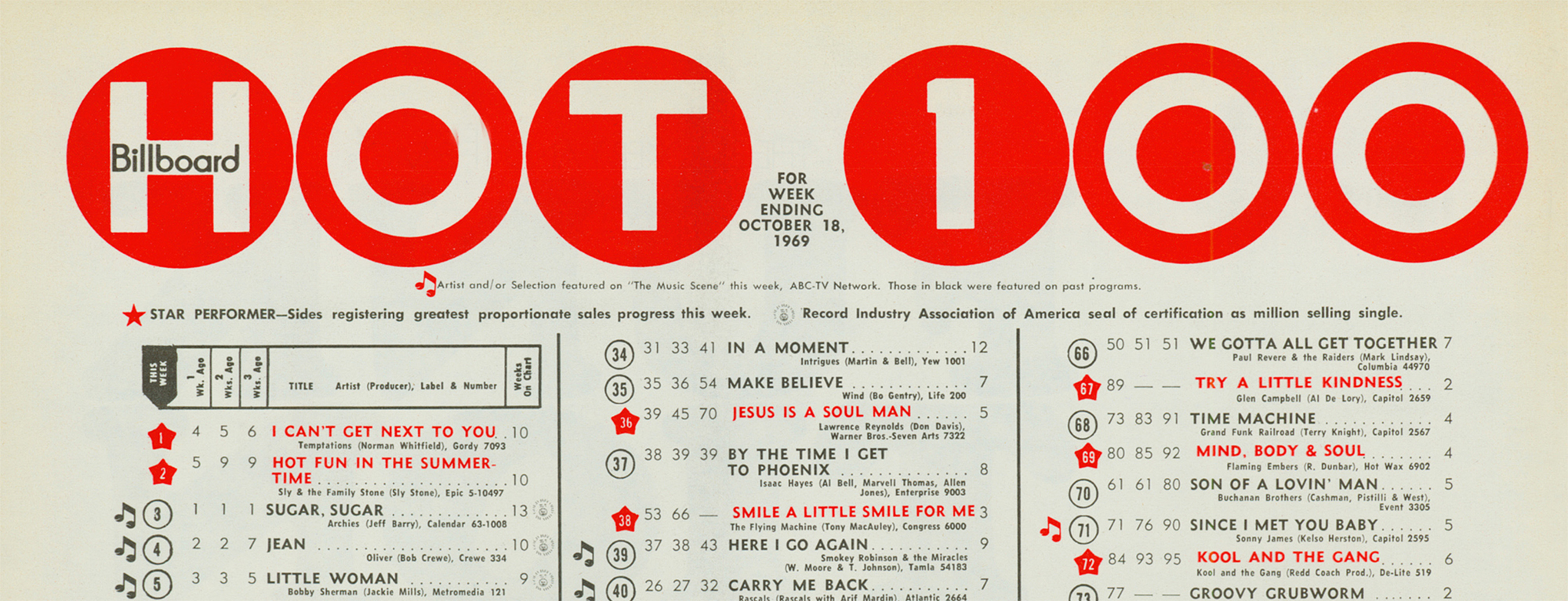
(Click on chart image 2x for detailed view)
___
SEVENTEEN WEEKS on the singles chart, “I Can’t Get Next To You” by the Temptations peaked this month at No. 01 (2 weeks) on the Billboard Hot 100. Week ending October 12 through October 25, 1969. (Source: Billboard)
___
MCRFB Link: For the previous No. 1 record in the U.S.A. 1969 GO HERE.
![]()

CKLW 20/20 NEWS * Don Patrick * OCTOBER 10, 1968



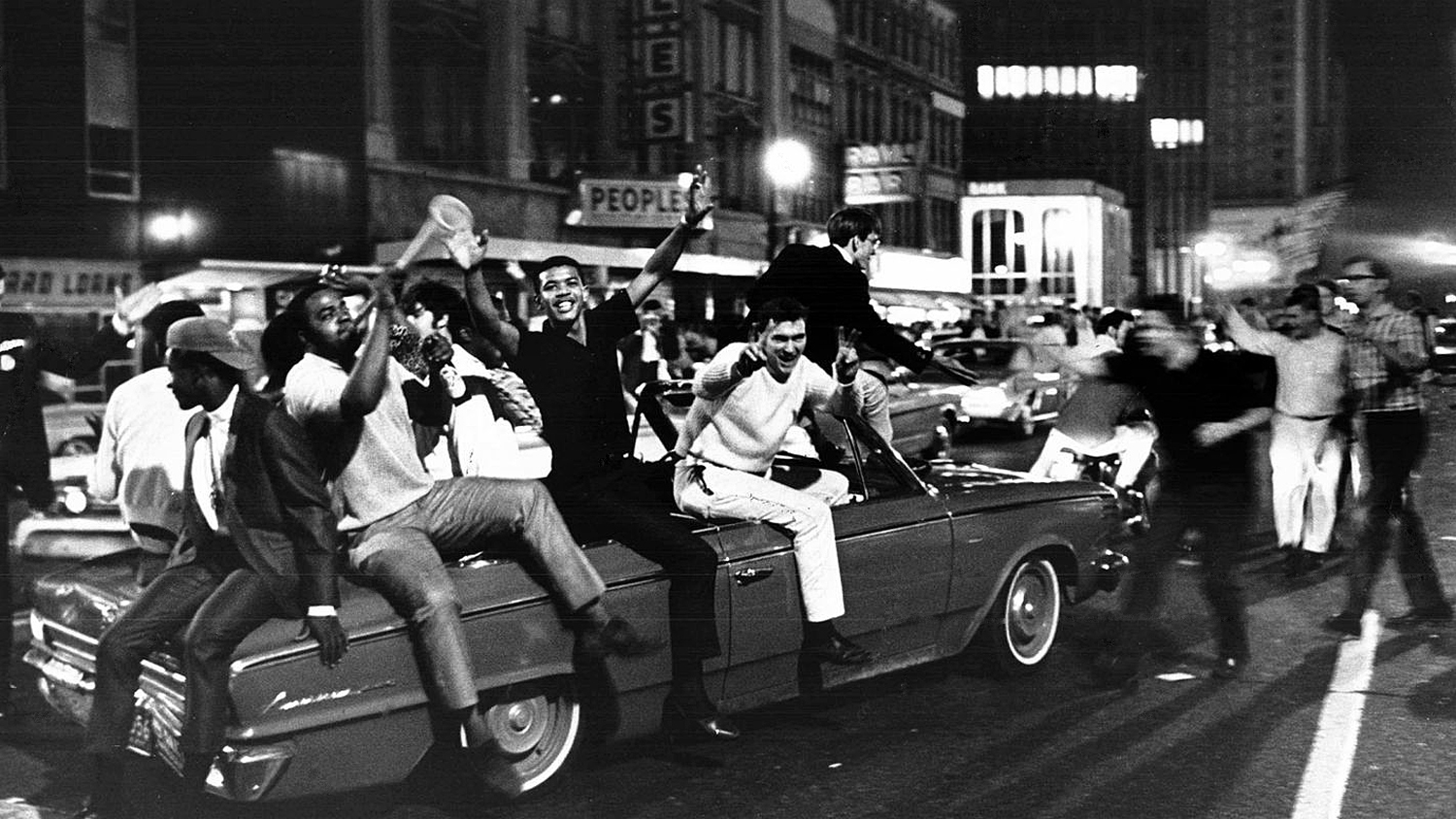

— ACKNOWLEDGEMENT —
A special THANK YOU to CKLW’s Charlie O‘Brien for sharing this (10/10/1968) Don Patrick 20/20 News memory with Motor City Radio Flashbacks.
— THE 1968 WORLD SERIES on NBC RADIO —
Motor City Radio Flashbacks featured the seven games of the 1968 World Series to commemorate the Detroit Tigers World Series victory over the St. Louis Cardinals — fifty years ago — last year in October.
All seven games of the 1968 World Series broadcasts over the NBC Radio Network is archived on this site, HERE.
*****
On your mobile device? Tap over newspaper images. Open to second window. “Stretch” image across your device screen to magnify for largest print view.
On your PC? Click on all newspaper images 2x for largest print view.

![]()
MCRFB Billboard News: 1965
Ascension of FM Radio Popularity Stokes Consumer Choice For 2 Band Radios, 1965
CHICAGO – Dealers have been reporting a revolution in radio sales that could see AM-only models go the route of 78 r.p.m. There is one exception to the trend: low-end AM portables in the $5-$10 range which serves as the vital link between the teenager and his rock ‘n’ roll radio station.
“Even in the moderate-cost table lines our customers want AM FM,” goes the typical dealer observation. The changing market is clearly reflected in factory sales figures just released by the Electronic Industries Association. And one need not go too much further in search of an explanation than the record of FM station growth during recent years (see chart below).
Sales Tripled
EIA figures show that sales of auto and home radios equipped to receive FM have more than tripled since 1960. An increase of 40 per cent above 1964 is expected before the end of next year. In 1960 – the year FM really started to catch hold – one FM receiver was sold for every nine radios purchased. Last year one of every four radios sold could receive FM. By 1966, EIA expects the ratio to increase to one of three.
AM-only sales have hovered between 16 and 20 million since 1960. Some 20 million of these sets are expected to move this year. Of the domestic-brand FM sets sold, the EIA has found that some 40 per cent are incorporated in phonographs, 25 per cent are table models and the remainder are portable or combined with clocks and TV sets.
Portables Lead
Portables have registered the highest rate of FM sales increase. Radio Advertising Bureau statistics indicate that 23 million FM sets were included in the 151 million reported in home use today. This share is expected to rise to 30 million of 161 million this year and 38 million of 170 million in 1966.
The increase in FM model sales has remained in step with FM broadcasting growth. While set sales have tripled since 1960, station number has increased from 821 in 1960 to 1,205 in 1964.
___
(Information and news source: Billboard; October 9, 1965)
![]()
Billboard and Recording Music Industry Pays Homage to Ray Charles’ on His Twentieth Year in the Recording Business, 1966

The record business since its earliest years has been marked by the occasional appearance of an artist whose career added something fresh, or unique, to the world’s musical heritage. Such an artist was Caruso; another was Gene Austin; and yet others were Duke Ellington and Charley Parker. The list is a wonderful one . . . it is a list of what may be called the “great originals” and it includes Jimmie Rodgers, Frank Williams, Elvis Presley and Frank Sinatra.
Each had his bag, as they say; and we may be grateful that several of the names are still carrying on in the great tradition. But the wellspring of talent never runs dry, and it is our pleasure to formally take note of – and document – the latest addition to the ranks of the “great originals.” Ray Charles is the name, as The Genius himself says in one of his early singles.
Ray has been on the scene some 20 years. His biography is the theme of another story; but for our purposes – the consideration of Charles as a recording artist – it is important to note that the years he spanned, two decades, were years of profound change in the music business.
Charles had recorded for some obscure labels on the West Coast in his initial years; but his first major development came when he joined Atlantic Records in 1952. “Root” influences were entering the mainstream of pop music. Rhythm and blues was selling in the pop market. This was an exciting blues – based music which was filling the vacuum created by the decline of the bands of the 1930’s and early 1940’s.
As the band business declined, the jazz world went off into new directions; and its prophets were Charley Parker, Dizzy Gillespie, Charlie Christian and others who flocked to Minton’s in Harlem. Locations like Bird – land and Bop City echoed with the new music. Simultaneously – in the late 1940’s and early 1950’s – in another segment of the music business, another “root” influence was about to enter the mainstream of pop music.
This was the country and western ‘field, with its spiritual home in Nashville. It was during this time that several pop artists – notably those recorded on Columbia by Mitch Miller – such as Tony Bennett, Rosemary Clooney and Joe Stafford, garnered big hits with such country material as “Cold Cold Heart,” “Half As Much” and “Jambalaya“.
In still another area of the world of music – Memphis – an innovator named Sam Phillips was laying the groundwork for a history – making musical development: the creation of the “rockabilly” sound, a fusion of blues and country as done by white artists such as Carl Perkins, Elvis Presley, Jerry Lee Lewis and Johnny Cash.
Assuredly, the times were changing. Tin Pan Alley, once centered in New York, had become the entire nation; and the wealth of American music was coalescing into one stream. Today it has coalesced in the artistry of Ray Charles. He has brought to the record buying public the elements outlined above – blues and country and pop; but “his bag” is infinitely greater, for it includes the great treasury of ballads written by the cream of composers affiliated with both ASCAP and BMI.
He is – in one – a great vocalist, a jazz pianist, a fine songwriter, a great arranger; and, as has been pointed out by Jerry Wexler, vice-president and general manager of Atlantic Records, Charles is a constant influence on the contemporary jazz scene. Indeed, he is one of the “great originals” – and this at a time when American music is richer and more complex than it has ever been.
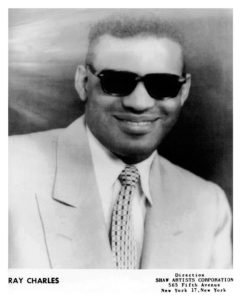
Ray in his early years was influenced by the great, late Nat King Cole and the noted rhythm and blues artist, Charles Brown. He then came to Atlantic (1952) and recorded his first sides – one of which was “Losing Hand,” a notable blues side, particular with regard to the piano and guitar interchange. The first recording date included another interesting side, “Mess Around,” a rousing uptempo blues, written by Ahmet Ertegun, the president of Atlantic. But thus far, Ray was not writing his own material or arrangements.
One year later, however, Atlantic recorded Ray while he was playing around New Orleans. The session, cut at radio station WDSU studios, produced “Don’t You Know” – not one of his big sellers but nevertheless a milestone record because it was a Ray Charles tune, a Ray Charles arrangement and a Ray Charles band.
The year 1954 was a very important one for Charles. He was now writing and arranging, and his famous gospel style -using gospel chord progressions -was very apparent in his work. Wexler recalls: “In November of 1954, Ray called us to Atlanta to dig his new band. We got with him in the afternoon at the Peacock nightclub . . . as soon as we walked in Ray counted off and they hit into ‘I’ve Got a Woman’ and that was it. Zenas Sears got studio time for us, and after much confusion we got out with a tape containing ‘I’ve Got A Woman,’ ‘Greenbacks,’ ‘Come Back Baby‘ and ‘Blackjack‘ . . . it had now happened. Ray was full-fledged, ready for fame.“
From this point forward, Charles made many hit records with his own songs, his own arrangements and his own seven -piece band. Until 1959, he emphasized his gospel-styled songs. Then in 1959 Atlantic cut the noted Genius” session. This featured six sides with strings and voices with arrangements by Ralph Burns. Six sides were done with a big band. This group contained Charles’ own small group plus Ellington and Basie sidemen.
Arrangements were by Quincy Jones, Ernie Wilkins and others. Released under the title, “The Genius Of Ray Charles,” this album opened up for Charles a new segment of the record audience.
So during his Atlantic years, Charles developed greatly in blues, giving it his distinctive gospel orientation; he also developed as a jazz artist, as an arranger and writer; and finally, he also showed his capacity for handling ballads, such as his great performance of the Johnny Mercer-Harold Arlen standard, “Come Rain Or Come Shine.”
During his term on Atlantic, Charles had brought to the awareness of the public the term “soul” (see separate story) as characterizing his type of performance. It is also worthy of mention that his Atlantic blues sides, in addition to their gospel feeling, contained Charles’ own version of the vocal break so characteristic of blues performances, and a diversity of interesting rhythm patterns including a rumba blues beat – as exemplified in his “What’d I Say” record. In these years he also developed his capacity for wit and humor, as illustrated by such sides as “It Should Have Been Me” and by his subtle voice inflections.
Finally – on June 26, 1959 – to be exact, Charles cut a prophetic record. This was “I’m Movin’ On,” written by the great country artist, Hank Snow. As Wexler had said: “Regardless of the genre -gospel, pop, even hill-billy, Ray Charles now has the world for an audience.”

How true. Charles was already very interested in country and western material. He was hip to the songs, to artists like Chet Atkins and Hank Snow, and he was getting ready to project himself to the public in new dimension-country music, with string and big band arrangements.
This was to happen early in Charles’ association with his new (and current) label – ABC. Charles’ recordings on ABC represent a flowering of his talent in many areas – all of them merging into one: pop. He took jazz, rhythm and blues, country and western and big ballads and gave to them all his unique touch; and sold them all in the mass market.
Ray’s first albums on ABC were “Genius Hits The Road” and “Dedicated To You“. These were not in the old Charles jazz or rhythm and blues style; the sides made use of big band arrangements, strings and a chorus, arranged and conducted by Marty Paich and produced by Sid Feller.
The first album produced the notable “Georgia On My Mind,” which became the nation’s No. I single. These two albums, with songs like “Georgia,” “Ruby,” and “Stella By Starlight” broadened Charles’ audiences. His exploration of sophisticated musical areas continued with such albums as “Ray Charles And Betty Carter,” using such great standard material as “People Will Say We’re In Love” and “Baby It’s Cold Outside,” with arrangements by Marty Paich and the Jack Halloran Singers.
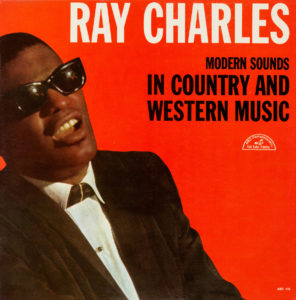
But a blockbuster development was coming: This was Charles’ increasing interest in country music. Two albums, “Modern Sounds In Country & Western Music, Volumes I and II,” were milestones in several ways. Volume I gave ABC its first million-selling album and this included the million-seller single, “I Can’t Stop Loving You,” the Don Gibson song published by Acuff-Rose. In Nashville, where Acuff-Rose headquarters, President Wesley Rose was heard to remark: “That man (Charles) has done a lot for country music.”
Rose, of course, was correct. Charles, a great performer with blues and with jazz, who subsequently proved his artistry with standard ballads, now was proving his artistry with the country and western idiom. The prophecy inherent in his recording of Hank Snow’s “I’m Moving On” was about to be realized. In a set of revealing notes written for the liners of the country albums. Rick Ward, ABC publicity advertising director, tells how a&r director Sid Feller was at first confused when Charles requested a list of country hits of the past 20 years. Sid started collecting the songs, and by the time the recording session was due, Feller was completely sold on the idea.
Working with arrangers Marty Paich, Gerald Wilson and Gil Fuller, Charles produced a body of recorded material which accomplished several things: I) The country sides gave Charles a new dimension – one which had been hinted at in his Atlantic era; 2) Charles’ recordings of country music gave the country field a new dimension, for it brought country music even more firmly into the pop mainstream of American music.
Meanwhile, in an industry which is marked by the phenomenon of changing tastes and artists of short-lived fame, Charles keeps on turning out hit after hit: “Hit The Road Jack,” “Busted,” “Let’s Get Stoned” and others, plus his current “I Chose To Sing the Blues.” The last two decades – the era of Ray Charles – have been important ones for musicologists and scholars of the social scene. These people have realized that integration developed on a musical level long before the present civil rights movement picked up steam.
In this article we have sketched the broad outlines of this development – the influence of Memphis and Presley; the influence of Nashville, and finally, the influence of Charles who saw and understood the entire scene and made it his own with his fusing of blues, gospel, country and standard ballads and jazz-making all of these musical forms desirable to the pop market. In this way, Charles exercised a highly significant socio-musical influence whose total effect on our culture is still gaining momentum.
Meantime, he has not forsaken any of the musical forms which have been part of his development. One of his albums, for instance, is titled “Together Again“
(from the hit song of the country writer-artist Buck Owens). This contains, in addition to the title song, a veritable pot-pourri of both country and rhythm and blues material.
It includes, for instance, Bill Monroe’s “Blue Moon of Kentucky,” which was the first song (and a country song at that) ever recorded by Elvis Presley. It also contains the country items, “I’ve Got A Tiger By The Tail” and “I Don’t Care,” and such rhythm and blues sides as “Watch It Baby” and “Maybe It’s Nothing At All.” This album, incidentally, was first issued under the title: “Country And Western Meets Rhythm And Blues“.
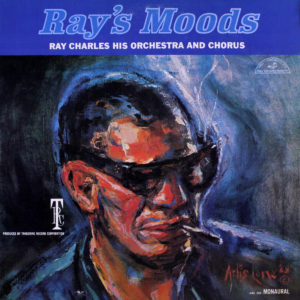
In his latest album, to be released momentarily, there is reflected the broadest range of material. Titled “Ray’s Moods,” this package presents something for all the different types of Ray’s fans. Those hankering for rhythm and blues have it in “What-Cha-Doing In There.” For the jazz buffs there’s “Chitlins With Candied Yams“. His ballad style is illustrated by “Please Don’t Say Goodbye,” and his whimsical, humorous side is reflected in “Granny Wasn’t Grinning That Day“.
And finally, for the country fan, there’s “She’s Lonesome Again.” Buffs of Ray’s piano style will like “Maybe Because It’s Love” and “It’s A Man’s World,” the latter with gospel chord progressions. And Ray, of course, is continuously an innovator, so in this package he sings “Sentimental Journey” as no one has ever done it before.
Such is the artistry of Ray Charles, whose career spanning two decades has brought together the diverse strands of American music fashioning them into a creation that is at once fresh and new while still remaining faithful to the roots from whence it all sprang. END
___
(Information and news source: Billboard; October 15, 1966)
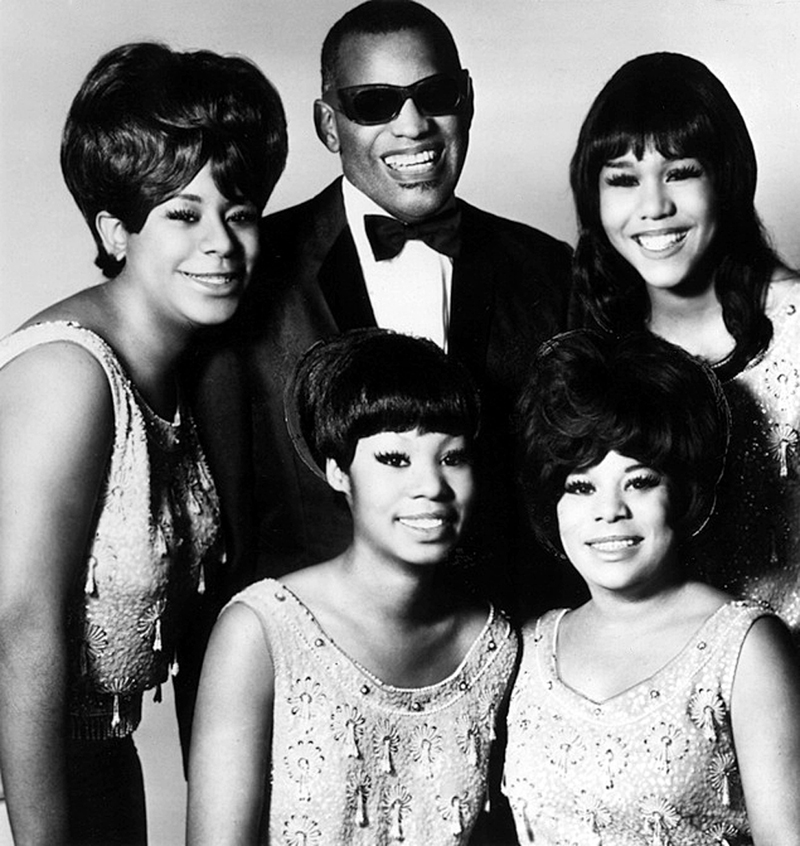

![]()
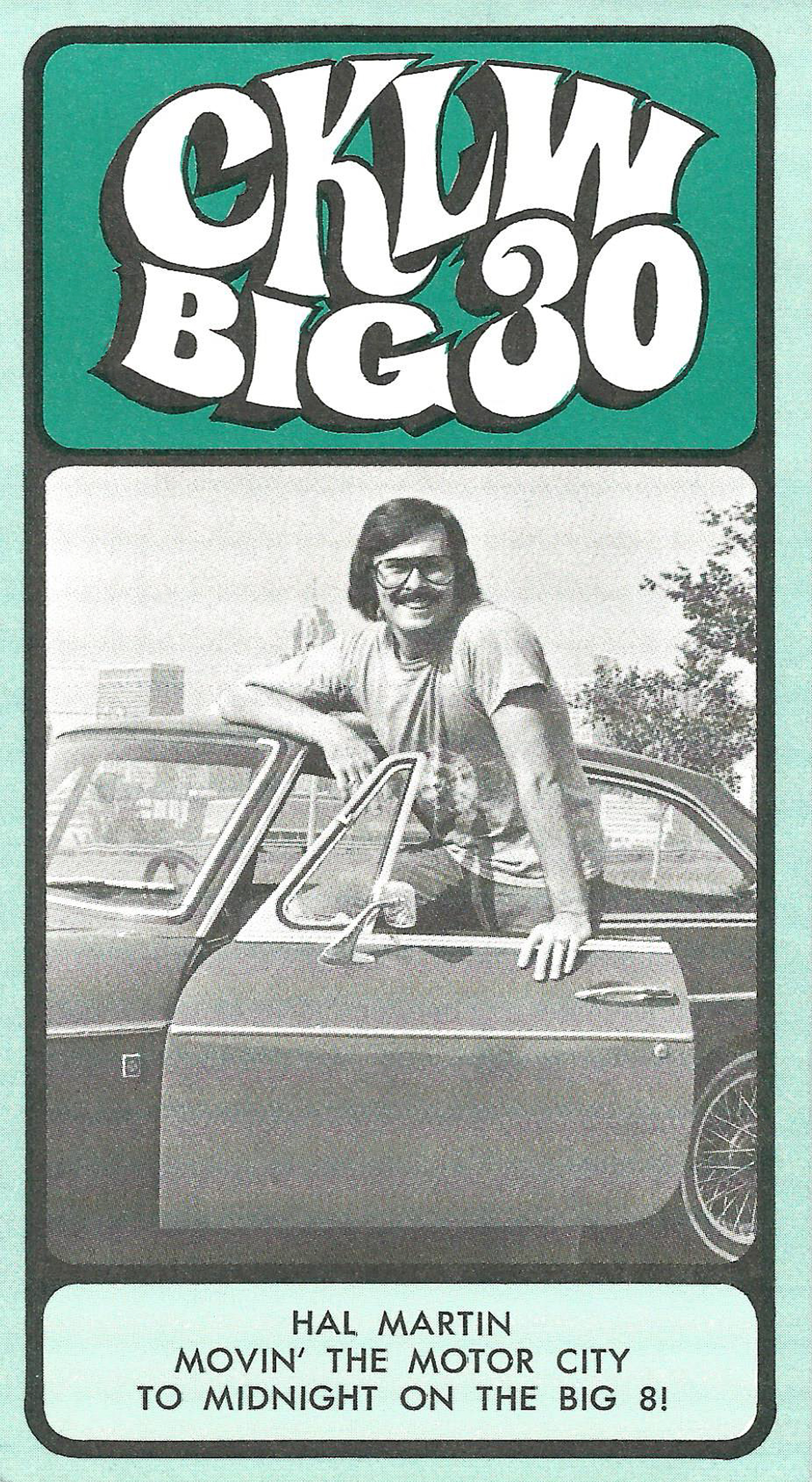



___
The CKLW BIG 30 hits in Windsor/Detroit. This survey was tabulated overall by record popularity appeal, sales, listener requests and record airplays based on the judgement of CKLW Radio.
Previewed for the week of September 27, 1971
On your mobile device? Tap over chart image. Open to second window. “Stretch” image across your device screen to magnify for largest print view.
On your PC? Click on all chart images 2x for largest print view.
— In Memory of George Griggs —
___
Above CKLW music chart courtesy of Mrs. Patti Griggs and the George L. Griggs estate.

![]()
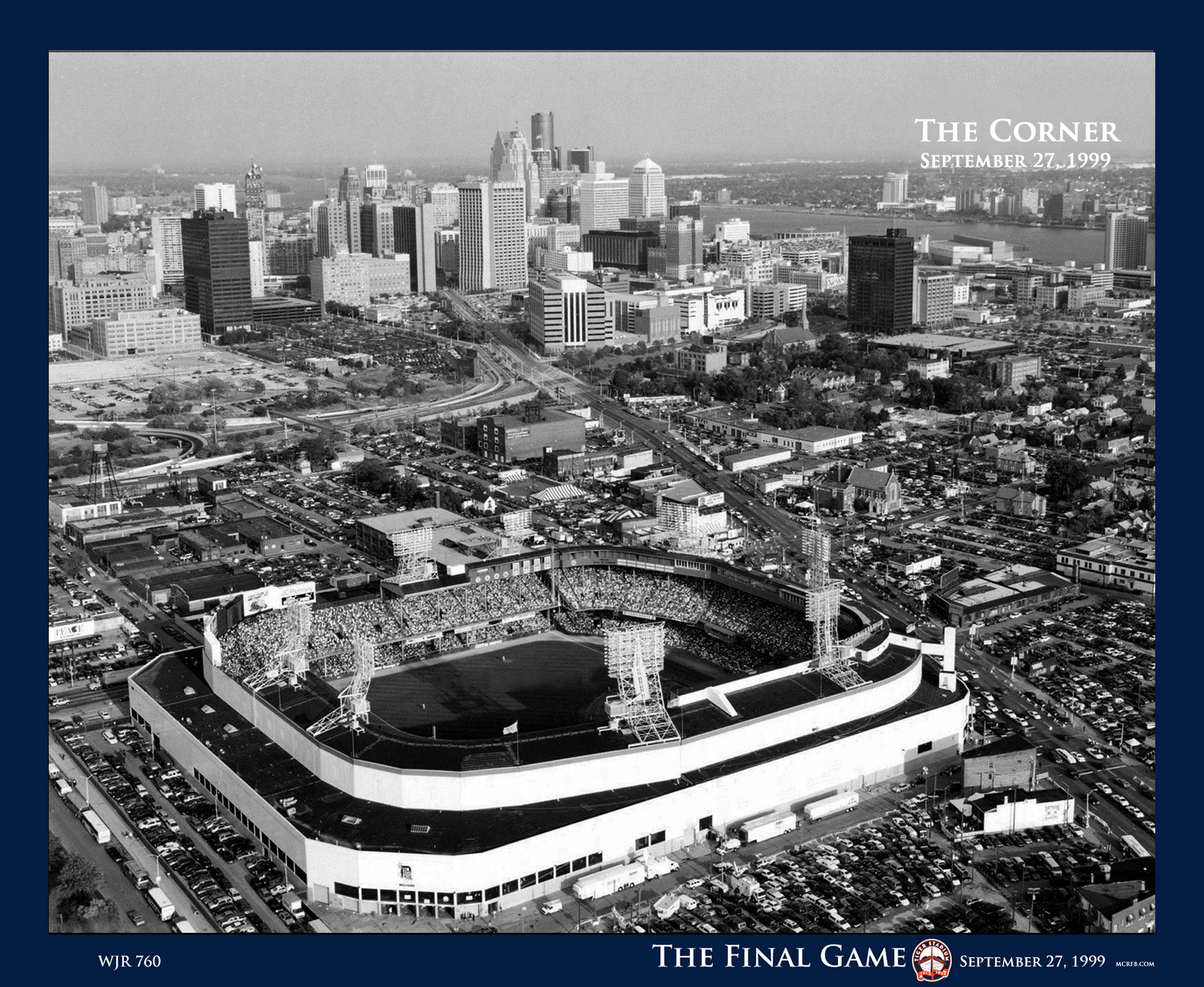
THE COMPLETE GAME FINALE * September 27, 1999 * 760 WJR [A]

By Bill McGraw and David Megoya
_______________
The Corner rocked.
Music blared everywhere. So many flashbulbs were popping at times Monday that it seemed as if the Beatles were taking the stage. Strangers talked baseball to strangers.
On the final day at Tiger Stadium, fans staged a festive wake for the old ballpark that featured heavy nostalgia, 65 old-time players and a rooftop grand slam.
The daylong celebration concluded with an emotional ceremony in which groundskeeper Charlie McGee dug up home plate with a pickaxe and took the precious cargo in a motorcade across downtown to the new Comerica Park.
Moments later, a cast of former Tigers took their old positions to loud applause and participated in a ceremonial lowering of the stadium flag.
The evening ended with many of the 43,356 fans standing at their seats, piano music playing over the public address system and the lights slowly going dark for the final time. As some fans daubed tears from their eyes and other beamed wide smiles, beloved announcer Ernie Harwell bid farewell to one of the most historic piece of baseball real estate in America.
“Tonight, we must say goodbye,” Harwell said, “So long old friend. We will remember.”
Cheers for players, stadium
The game highlight was Robert Fick’s based-loaded home run that slammed into the roof in right-field and bounced back into the field. The blast iced the game for the Tigers, and Fick, hardly a household name in the game, was signing autographs well into the night.
After the game, fans grew hoarse cheering for the former Tigers who entered the field from centerfield for the closing ceremony as music from “Braveheart” played. First to appear was Mark “The Bird” Fidrych, the sensation of the mid-1970s who ran to the pitcher’s mound and scooped dirt into a plastic bag.
Players who received some of the loudest cheers were hometown favorites Willie Horton, Kirk Gibson and Ron LeFlore. Fans also screamed for Alan Trammel and Lou Whittaker, Gates Brown and Al Kaline. Some fans seemed stunned to see some long-forgotten heroes as Jim Bunning, Eddie Yost and Charlie (Paw Paw) Maxwell.
“Awesome, just awesome,” gushed Richard Coriaty, 36, a former Detroiter who traveled from Fontana, Calif. for the game.
Coriaty swept his hand toward the field, where the players assembled, dressed in the plain white uniforms with the old English D on their chest. “You know, of all the . . . things that have happened in this city, the one thing we all have in common is those guys out there.”
And the old building that became our field of dreams. END

 — Detroit Free Press | Tuesday, September 28, 1999 —
— Detroit Free Press | Tuesday, September 28, 1999 —
Note: The above article was condensed for this presentation. The article appeared on the front-page of the Detroit Free Press, as dated.
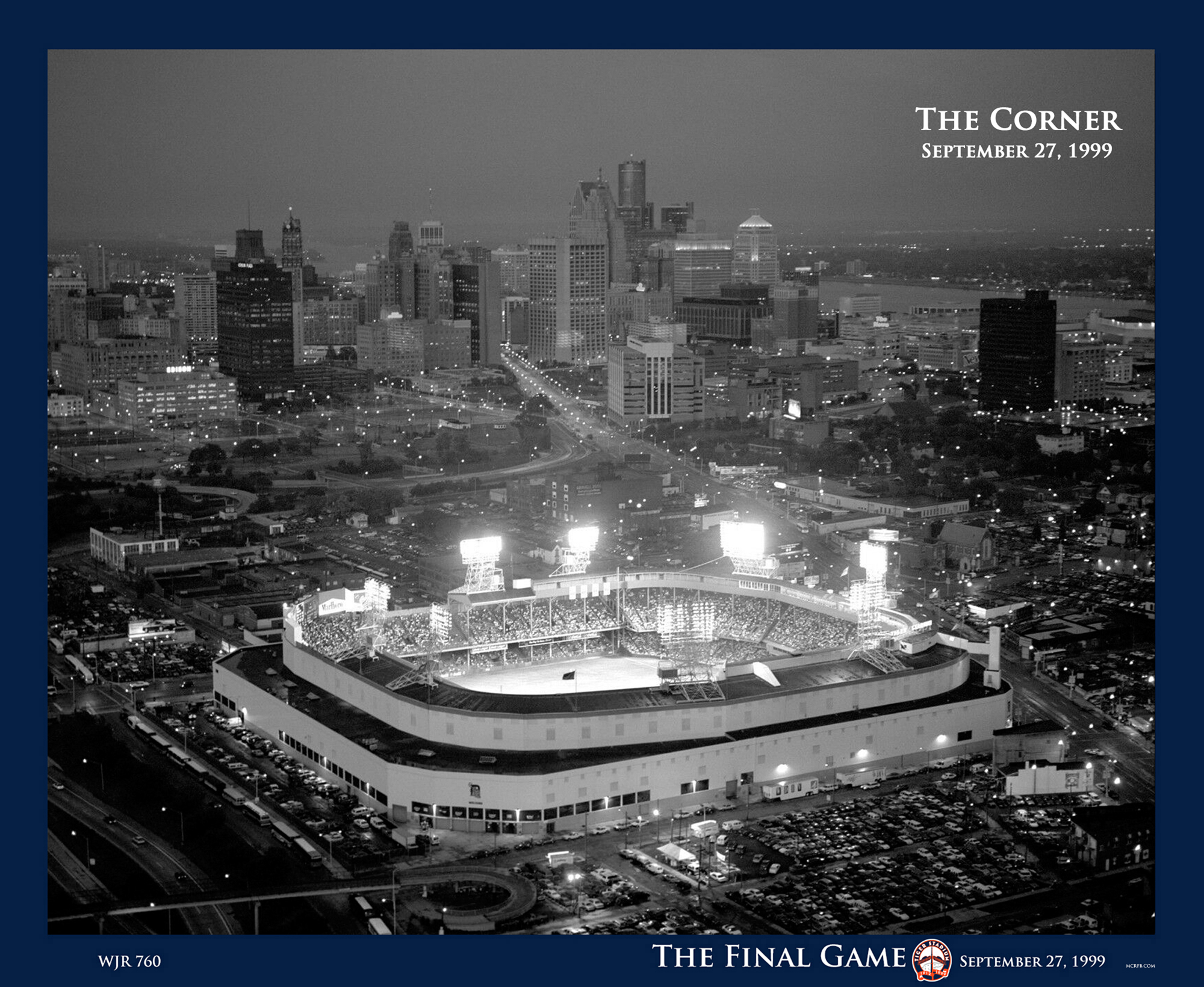
THE COMPLETE GAME FINALE * September 27, 1999 * 760 WJR [B]

— THE FINAL GAME at TIGER STADIUM —
Motor City Radio Flashbacks presents today the entire ‘Last Game at Tiger Stadium’ as was aired on WJR 760.
Well aware of the stadium’s historic, long anticipated closure scheduled for that day, this author recorded the historic last game and kept (sealed) the 3 tapes ever since — 20 years now having passed.
In 2013, fourteen years after the game was recorded the tapes were played for the very first time. Found to be in remarkable pristine sound at first listen, the recordings were then transferred to CDs (and as back-ups) to preserve and retain the original source.
This past July, I reprocessed the CD files to digitized mp3 format for today’s featured presentation. The entire game (and files) will be archived on this site at a future date.
Comprised of over 5 and a half hours of recorded tapes, you will hear: the entire pre-game ceremonies; the pre-game show; the entire ball game; the post-game show; the entire post-game ceremonies.
You will hear the play-by-play voices of Ernie Harwell and Jim Price. The voices of Dan Dickerson; Paul W. Smith; Steve Courtney; Bo Schembechler; George Kell; Frank Beckmann; Al Kaline; Mike Illitch; Mayor Dennis Archer; Governor John Engler; Baseball Commissioner Bud Selig.
Also (former Tiger manager and Tiger players) Sparky Anderson; Willie Horton; Brad Ausmus; Jeff Weaver; Francisco Cordero (and former ’30s-’40s Tiger great) Elden Auker.
_______________
In commemoration of the closing of Tiger Stadium, Motor City Radio Flashbacks presents the complete game finale — Kansas City vs. Detroit — as was played at the Corner, Monday, September 27, 1999. Twenty years ago today.
A special day in Tiger history.
— ACKNOWLEDGEMENT —
A special THANK YOU to Charlie O’Brien for his assistance in editing these recordings.

THE LAST HOME RUN * Ernie Harwell * SEPTEMBER 27, 1999

— ABOUT THESE IMAGES —
Above newspaper images courtesy from the freep.com newspaper archive. Copyright 2019. Newspapers.com.
The above featured images was ‘clipped,’ saved, and imaged from the credited source by Motor City Radio Flashbacks
— A VIEWING TIP —
To fully appreciate the above featured newspaper images on your PC click on image(s) 2x and open to second window. Click image anytime to return to NORMAL image size.
If viewing on your mobile device, tap over newspaper images. Open to second window. “Stretch” images across your device screen to magnify detailed view.
All images posted in this featured presentation was created in their presented form by the author.
All newspaper images courtesy of the Detroit Free Press
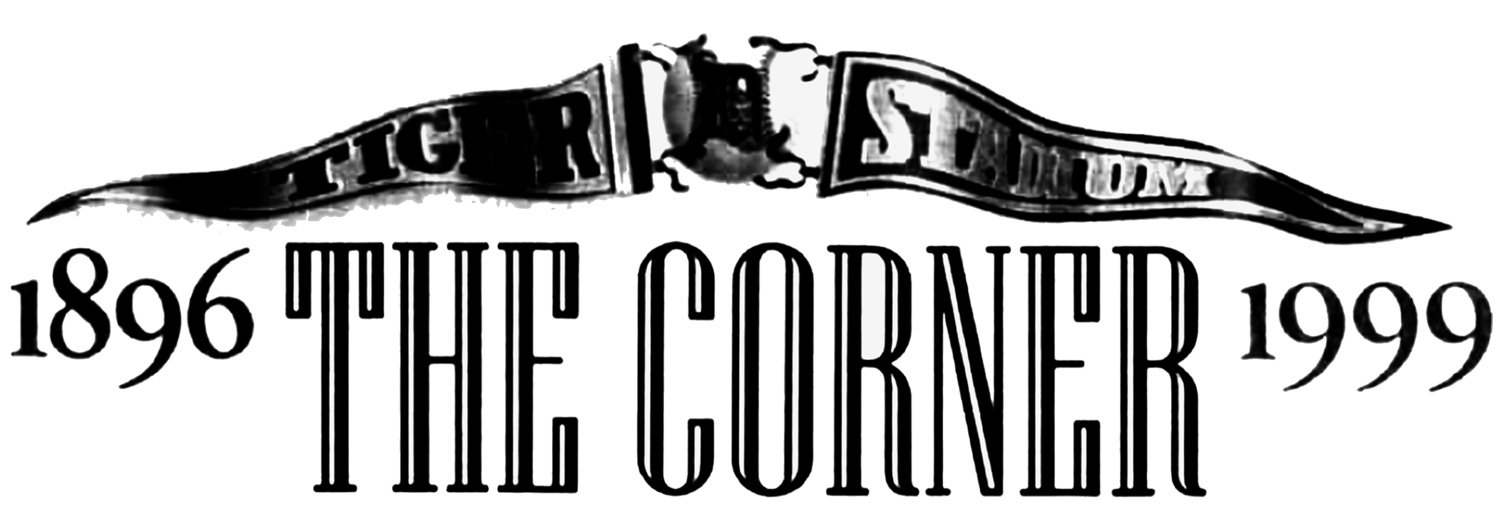
_______________
The Pre-Game Ceremony
Prior to the final game at Tiger Stadium, a ceremony was held. It was emceed by then current Tiger broadcaster and Ford C. Frick Award recipient Ernie Harwell. At the ceremony, owner Mike Ilitch spoke along with then Michigan governor John Engler, then Detroit mayor Dennis Archer and Commissioner of Baseball Bud Selig. Also featured at the ceremony was longtime Tiger right fielder and Hall of Famer Al Kaline.
Instead of both managers exchanging lineups before the game, both clubs appointed honorary captains. Representing the Tigers was Al Kaline and representing the Royals was former MVP and Hall of Fame third baseman George Brett.
The Post-Game Ceremony
The game ended at 7:07 pm. The grounds crew then surrounded home plate. Groundskeeper Charlie McGee, using a pick axe, dug up home plate at 7:13. It would then be transported by Tiger pitchers Matt Anderson, Jeff Weaver, and Francisco Cordero, with police escort, to Comerica Park.
Ernie Harwell then read a history of Tiger Stadium accompanied by music from the movie Field of Dreams. He introduced a film containing images of such Tiger legends as Ty Cobb, Sam Crawford, Hughie Jennings and Harry Heilmann. In addition, the Tigers Hall of Famers were honored: Heinie Manush, Mickey Cochrane, Charlie Gehringer, Hank Greenberg, Hal Newhouser, George Kell, and Harwell.
Following remarks from Willie Horton and former manager Sparky Anderson, there emerged from the center field gate players from times past, including Mark Fidrych, Bill Freehan, Dick McAuliffe, Dave Bergman, Mickey Stanley, Willie Horton, Kirk Gibson, Cecil Fielder, Al Kaline, the combination of Alan Trammell and Lou Whitaker, and Elden Auker. A line was formed from the center field flagpole to home plate, along which was passed the flag that had flown from the pole in dead center over the finale.
After Auker passed the flag to catcher Brad Ausmus, players threw souvenirs into the stands as some reached over and put dirt from the warning track into plastic bags. It was at this time that Harwell gave his final goodbye: “Tonight, we say good-bye . . . Farewell, old friend Tiger Stadium. We will remember.”
At 8:19, the scoreboard was shut off. At quarter to nine, a final team picture was taken, and by 9 the stands were empty. As the last of the fans left, a sign was hung on the famous right-center field overhang which read: “Today, there is crying in baseball. So long, old friend.”
(Source: ‘Final Game at Tiger Stadium‘; Wikipedia)
A TRIBUTE TO TIGER STADIUM * Mike Whorf * SEPTEMBER 27, 1999


![]()